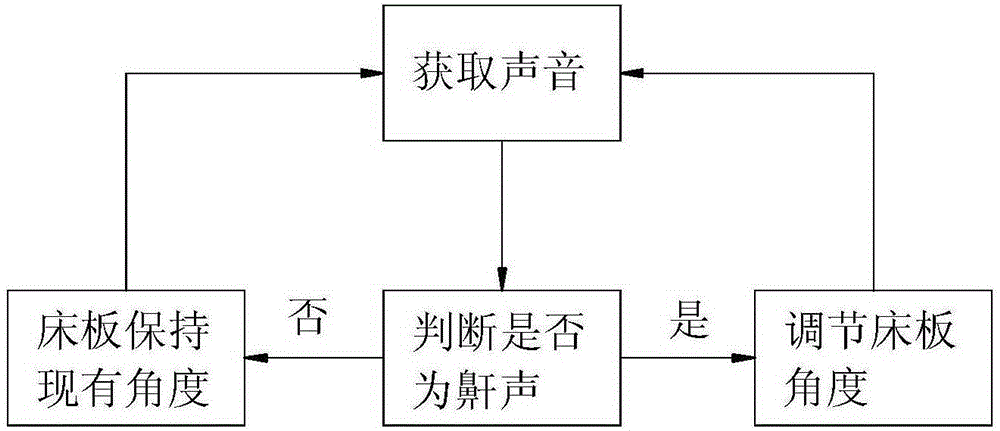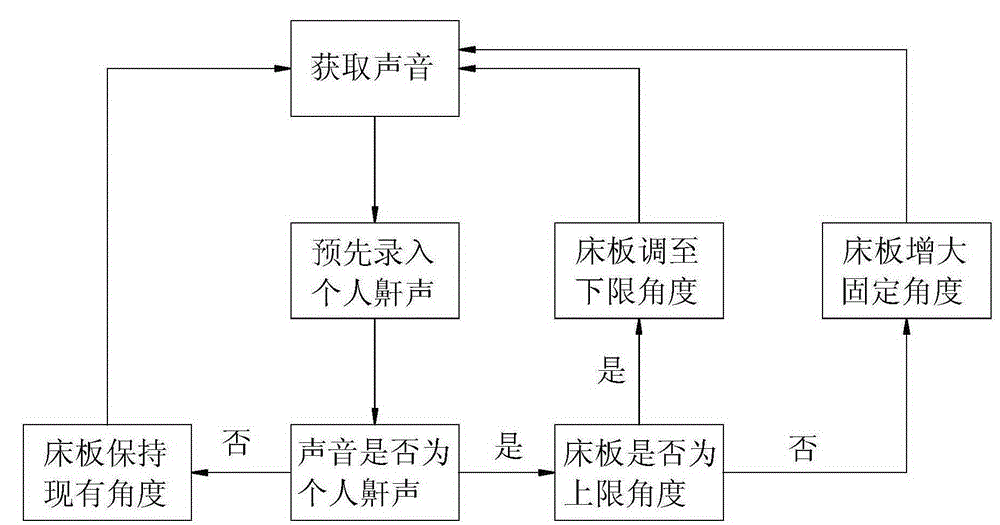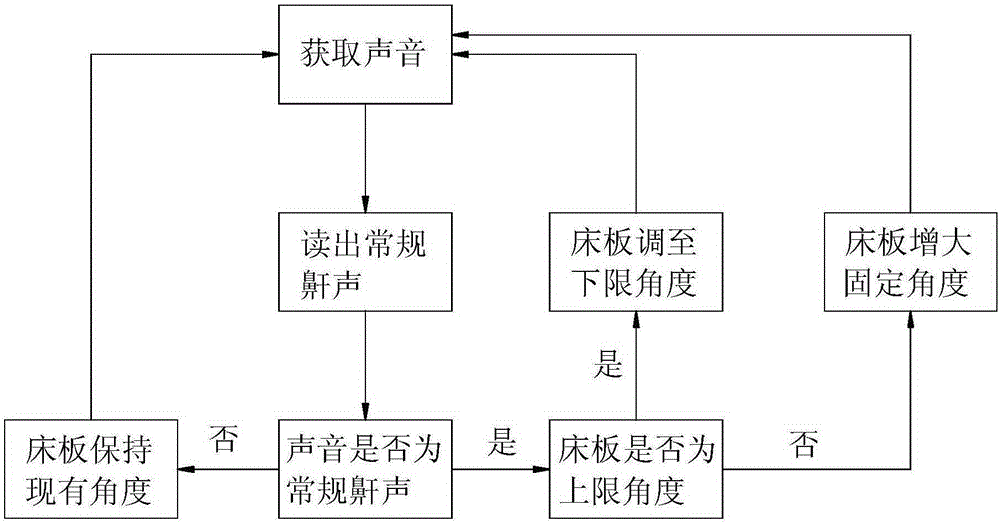Method for inhibiting snoring and intelligent bed
A smart bed and bed board technology, applied in the method and smart bed, suppressing snoring, can solve problems such as inability to work and study, dizziness, etc., and achieve the effect of improving judgment accuracy and avoiding misadjustment
- Summary
- Abstract
- Description
- Claims
- Application Information
AI Technical Summary
Problems solved by technology
Method used
Image
Examples
Embodiment 1
[0093] On the one hand, if figure 1 As shown, a method for suppressing snoring is provided, by adjusting the angle of the smart bed to suppress snoring, which specifically includes the following steps:
[0094] Get the sound in the room;
[0095] Determine whether the sound is human snoring:
[0096] If not, keep the current angle of the bed board, and return to the step: obtain the sound in the room;
[0097] If so, adjust the angle of the bed board once in a preset manner, and return to the step of obtaining the sound in the room while adjusting or after the adjustment is completed.
[0098] In this embodiment, the above steps are: adjust the angle of the bed board once in a preset manner, and return to the step after the adjustment is completed: acquire the sound in the room.
[0099] Medical research shows that any pronunciation needs to pass through the activities of various muscles in the oral cavity, nasal cavity and pharyngeal cavity, and the sound will only be made...
Embodiment 2
[0121] The difference between this embodiment and Embodiment 1 is:
[0122] like image 3 As shown, the steps: judging whether the sound is human body snoring specifically includes the following steps:
[0123] Read out the routine snoring sounds of several different groups of people stored in the control system;
[0124] Comparing the acquired sounds with the conventional snoring sounds one by one to determine whether the sound belongs to any of the conventional snoring sounds.
[0125] In this embodiment, the regular snoring sound has been pre-stored in the control system when the smart bed is produced, without manual input by the user or a second party.
[0126] In this embodiment, if image 3 As shown, the steps: adjust the angle of the bed board once in a preset manner, specifically:
[0127] Determine whether the current angle of the bed board is the upper limit angle:
[0128] If so, adjust the angle of the bed board to the lower limit angle, and use the adjusted b...
Embodiment 3
[0138] The difference between this embodiment and Embodiment 1 is:
[0139] like Figure 4 As shown, the steps: judging whether the sound is human snoring is specifically:
[0140] It is judged whether the loudness of the sound is greater than or equal to a preset snoring decibel value.
[0141] In this embodiment, if Figure 4 As shown, the steps: adjust the angle of the bed board once in a preset manner, specifically:
[0142] Determine whether the current angle of the bed board is the upper limit angle:
[0143] If so, reduce the angle of the bed board to a fixed angle, and use the adjusted bed board angle as the existing angle;
[0144] If not, judge whether the current angle of the bed board is the lower limit angle:
[0145] If so, increase the angle of the bed board to a fixed angle, and use the adjusted bed board angle as the existing angle;
[0146] If not, judge whether this adjustment to the bed board angle is the first adjustment:
[0147] If so, increase th...
PUM
 Login to View More
Login to View More Abstract
Description
Claims
Application Information
 Login to View More
Login to View More - R&D
- Intellectual Property
- Life Sciences
- Materials
- Tech Scout
- Unparalleled Data Quality
- Higher Quality Content
- 60% Fewer Hallucinations
Browse by: Latest US Patents, China's latest patents, Technical Efficacy Thesaurus, Application Domain, Technology Topic, Popular Technical Reports.
© 2025 PatSnap. All rights reserved.Legal|Privacy policy|Modern Slavery Act Transparency Statement|Sitemap|About US| Contact US: help@patsnap.com



